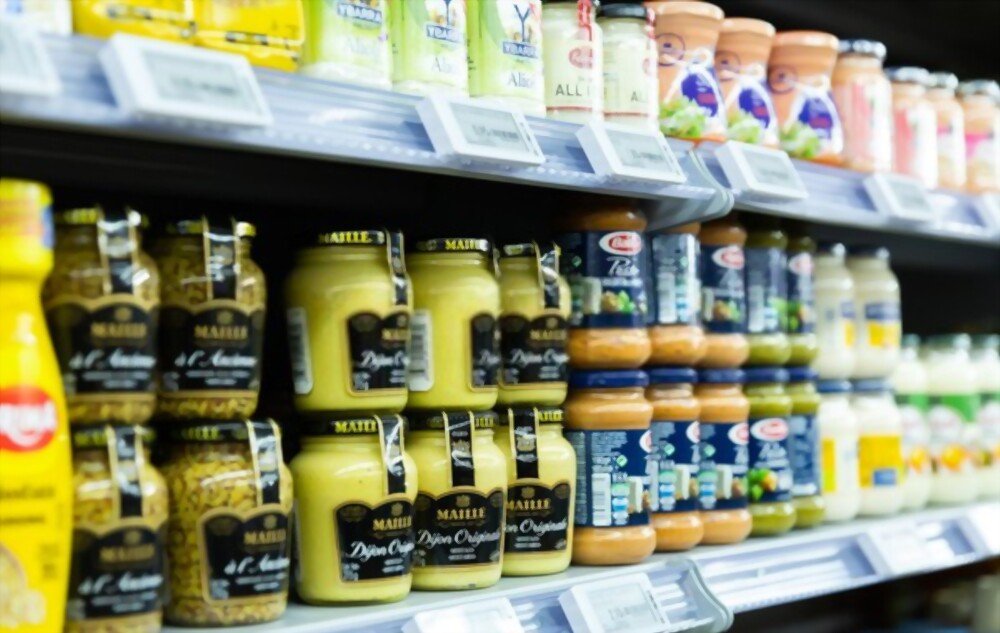Bottled and Jarred Packaged Goods
During your shopping, you may see various types of food packaging on the racks of the shopping malls. Few foods are available in cans, whereas others are in glass jars or plastic bottles. Ancient Egypt used glass canisters with airtight lids to pack goods and food items. These were used for the home chemicals. Until 1900, there was no research and innovation in food packaging, but packaging has changed drastically with the evolution of technology. During the 1900s, the very first bottle-making machine was created. This was when manufacturers started the mass production of all kinds of packaged goods. Glass jars and bottle containers are becoming famous day by day with high demand as the problem of carrying and distributing goods and products to the customers has minimized a lot.
Food packaging depends on the food type, preservation method, storage requirements, and expiry date. You may also see food wrapped in foils. Every kind of food packaging is different from others and has advantages and disadvantages. Manufacturers consider different factors before deciding the packaging type for a specific food. These factors include handling, recycling, health, and disposal of the packed product.
Convenience is the major factor that impacts food packaging, but other hidden factors are also. You might have little awareness and knowledge, but you can still guess the type of food packaging that is good in terms of hygiene and health.
Main Objective
The main and basic purpose behind various kinds of food packaging is to preserve and save the food in the best way and for the proper time. The food packed includes ready-to-use food items like fish, vegetables, meat, pet food, fruits, and meat. Other than food items, it includes toothpaste, shampoo, and many other supplies for home, office, and malls.
Importance of Packaging
Good packaging is very important; that is why manufacturers spend a lot of time researching and spend a lot of money on packaging. Safe and secure storage and transportation are easy if the packaging is good. Good packaging saves and protects the food in the bottles and jars from all kinds of harmful contaminants for human beings. When we talk about food storage, bacterial growth is the big issue that arises over time. Glass bottles and jars keep the food safe from bacterial growth, keeping the food and drinks safe for months. With good packaging, food and content in the bottles and jars are easy to store and deliver from one place to another. Manufacturers attract customers to buy their products with great packaging that best presents their goods and commodities. If the product is packed attractively, it can appeal to more customers.
Commonly Used Packaging
Below is the list of commonly used packaging used by makers to sell their products and goods.
- Glass canisters with lids
- Foil pouches
- Tins
- Cardboard packaging
- Aluminum containers
- Metal containers
- Cans
- Plastic bottles
- Glass jars
- Wooden packaging
- Plastic jars
- Plastic tubes
- Boxes
Examples of plastic bottles are cheese platters, yogurt cups, and beverages. Cardboard packaging is used for takeaway meals, fruit and vegetable boxes, nut tubs, condiment tubes, and frozen food boxes. Metal wrapping is used for fruits, vegetables, and meat. Beer, jam, olives, pickles, and mushrooms are usually in glass jars.
Advantages of Bottled and Jarred Packaged Goods
Packaged goods are safe and ready to use. They have various advantages that you may enjoy while using packaged goods and products.
- With time, drinking water is mixed with sewage water; people now prefer sealed plastic bottles rather than drinking tap water.
- In glass canisters, many goods and products are safer and hygienic than food packed in cans. It is a major benefit that people can recycle and reuse glass canisters.
- Glass jars do not contain any chemical that is harmful to human beings.
- There are various kinds of foods available in the market that need to be stored carefully to avoid bacteria. Fruit must be carefully packed because of its short shelf life.
- Packaged goods are not so expensive and have a longer shelf life.
- Glass jars are transparent so customers can make easy and quick decisions during their shopping.
- Glass jars are environment friendly and do not harm our surroundings, and keep our environment a safe, healthy, and happy place to live in.
- Makers do not compromise on quality when they pack something in glass jars. These are easy to store and transport as they consume less space.
- They are available in different sizes and shapes. You can choose any size according to the quantity you need to buy.
Disadvantages of Bottled and Jarred Packaged Goods
Every packaging has its disadvantages as well that are given below
- Glass jars are easily breakable because they are made from glass.
- Glass bottles are expensive because of careful storage, handling, and transportation.
- Plastic trash has increased in recent years because of the excessive use of plastic packaging.
Packaged Goods to Avoid
Packaged goods are safe and good to buy. There are some items that you must avoid buying during your shopping. Agave syrup is one of them. It is expensive and has a high chance of getting worse when heated. As it is not hygienic, prefer some alternative if you need a good sweetener. Never choose a product with the label ‘enriched’ as these products have fewer nutrients that will keep you lazy, tired, and restless. Vegetable oils packed in can cause cancer as they are derived from natural ingredients. Fortified foods are rich in minerals and vitamins, but they have adverse effects, so avoid buying them and prefer fresh fruits and vegetables to meet minerals and vitamins deficiency.
Concluding Remarks
Bottled and jarred goods are safe for human beings and the environment in which we live. Goods packed in plastic containers are not good, so never buy them. These packages emit chemicals that are harmful to both people and the environment. When you are on a shopping trip, buy products carefully as health is the most important factor in living a happy life.



